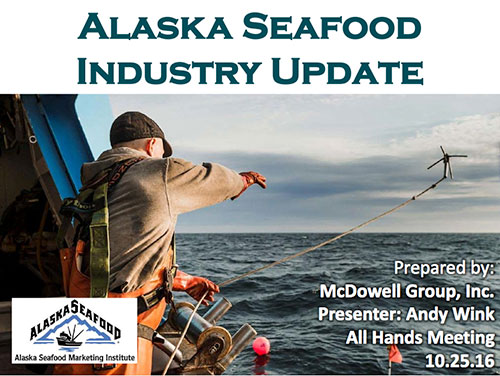|
Fish Factor Alaska seafood market updates and outlooksBy LAINE WELCH
November 25, 2016
Alaska produces more than 65 percent of our nation’s wild caught seafood; seafood also is Alaska’s top export to other countries. Alaska Seafood Industry Updates, Here are some highlights from the Alaska Seafood Industry Updates prepared each fall by the McDowell Group for the Alaska Seafood Marketing Institute: The value of Alaska seafood at the docks dropped seven percent from 2011 through 2015 to $4.3 billion. Salmon was tops for dockside values for 2014 - 2015 at $541 million, 29 percent of the value of all Alaska seafood catches. Pollock ranked second for Alaska seafood value at $477 million, 26 percent of the total dockside value and 54 percent of the volume. Alaska’s total salmon supply picture for 2016 is down 58 percent. Global farmed salmon production won’t regain steam until 2019, and reports are circulating widely that the prized omega 3’s are down by half in farm grown fish due to their plant-based diets. At Bristol Bay, the preliminary value to salmon fishermen increased 66 percent, due to a big sockeye catch and higher prices. Alaska salmon prices continue to increase at wholesale and the fresh market is growing stronger, especially for sockeyes. Markets for pollock, cod, flounders and other ‘whitefish’ are likely `to remain steady, but with low prices. Prices for king and snow crab are expected to set records, but will face stiff competition from Russian imports to the U.S., up 58 percent and 38 percent last year, respectively, valued at over $220 million. The halibut market is likely to remain flat, or may go down a bit after sustaining fishermen’s prices in the $6 to over $7 per pound range all season. Global currency markets remain challenging for seafood trade, but have improved. A concern cited by the report is budget cuts to the commercial fisheries budget which shift the onus to fishermen and processors to fund critical management projects through test fisheries. Another is the ongoing U.S. food embargo by Russia, now entering its third year. For Alaska, the seafood shut-out adds up to a $60 million hit each year, primarily from lost sales of pink salmon roe and Alaska pollock products. Almost 90 percent of the king crab eaten in the U.S. comes from Russia, according to market expert John Sackton, much of it caught illegally. The U.S. also buys thousands of tons of pollock, cod and salmon from Russia each year. “If Russia won’t buy our seafood, we won’t buy theirs,” has been the way Alaska processors and crabbers hoped to hit back on the ban. They have been urging Congress and the President to enact a retaliatory ban on seafood coming into the U.S. from Russia, so far, to no avail. The Salmon Sisters of Homer have partnered with Silver Bay Seafoods to get more Alaska seafood into the mouths of needy Alaskans. For every purchase of Salmon Sisters clothing, accessories or home goods, a can of salmon is donated to the Alaska Food Bank. The canned fish is pink salmon caught by Silver Bay Seafoods’ seine fleets at Prince William Sound and Southeast Alaska. “It’s shelf stable, it’s delicious and it is easy to get around the state,” said sister Claire Neaton, adding that the food bank is supplying more than 60 Alaska communities. “As fishermen we have constant access to Alaska seafood. We forget that it’s not the case in the entire state. We wanted to share our salmon with other Alaska communities, and what better way to get our catch on their plate,” she said. The Give Fish Program is a “forever project.” The team’s first donation of almost 15,000 cans was distributed in late summer and they plan on another shipment for the holidays. Look for Salmon Sisters goods at local gear stores and online. The call is out for nominations for SeaWeb’s 2017 Seafood Champion Awards. The awards recognize individuals and organizations in four categories: leadership, innovation, vision and advocacy. Nominees should demonstrate outstanding commitment to advancing seafood sustainability in the fishing, aquaculture, supply and distribution, retail, restaurant or food service sectors, or through conservation, science, academia or the media. Self-nominations are allowed. SeaWeb is a project of The Ocean Foundation. Find guidelines and nomination forms at www.seafoodchampions.org/ The deadline for nominations is Dec. 3.
Laine Welch ©2016 Laine can be reached
at msfish[AT]alaska.com
Representations of fact and opinions in comments posted below are solely those of the individual posters and do not represent the opinions of Sitnews.
SitNews ©2016 Stories In The News Ketchikan, Alaska
|
||

